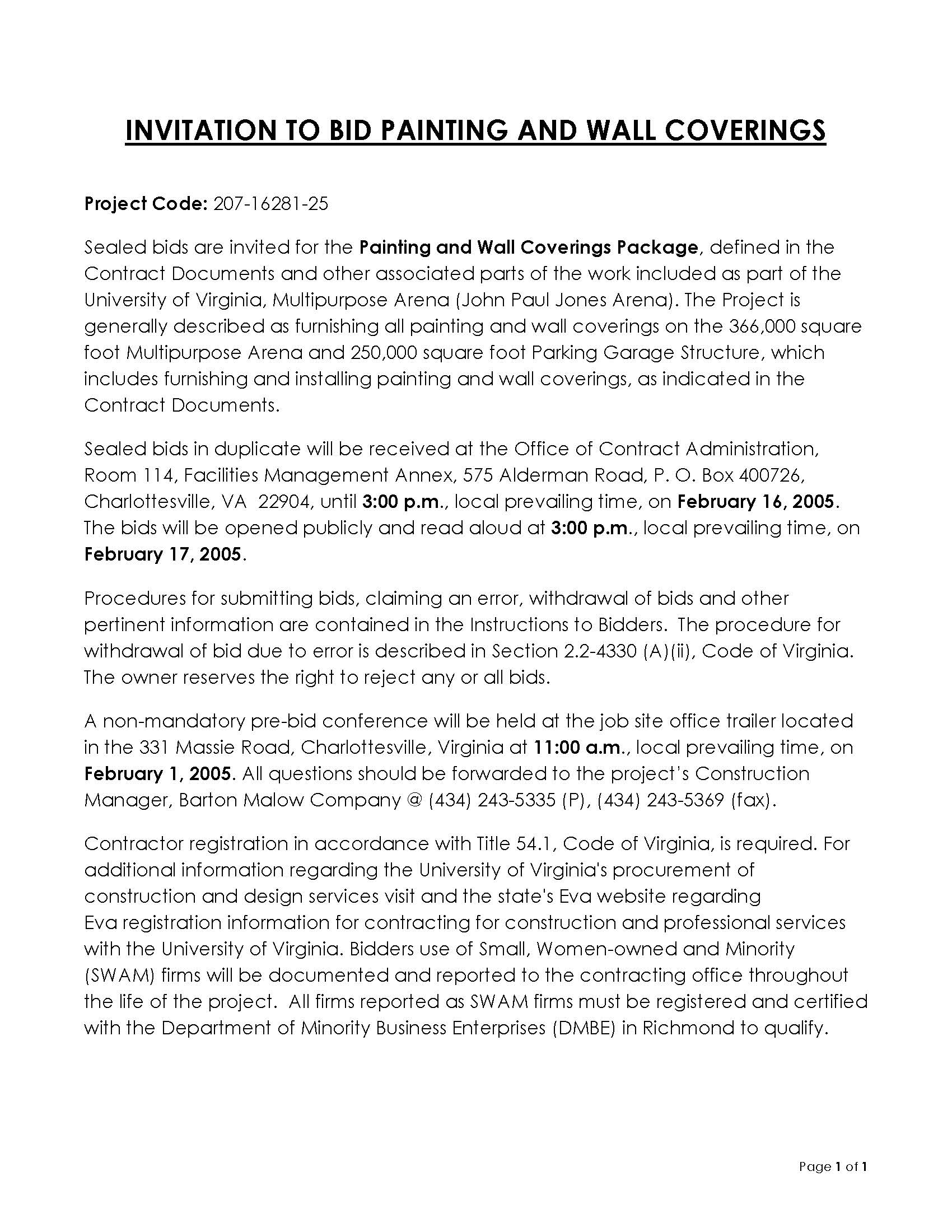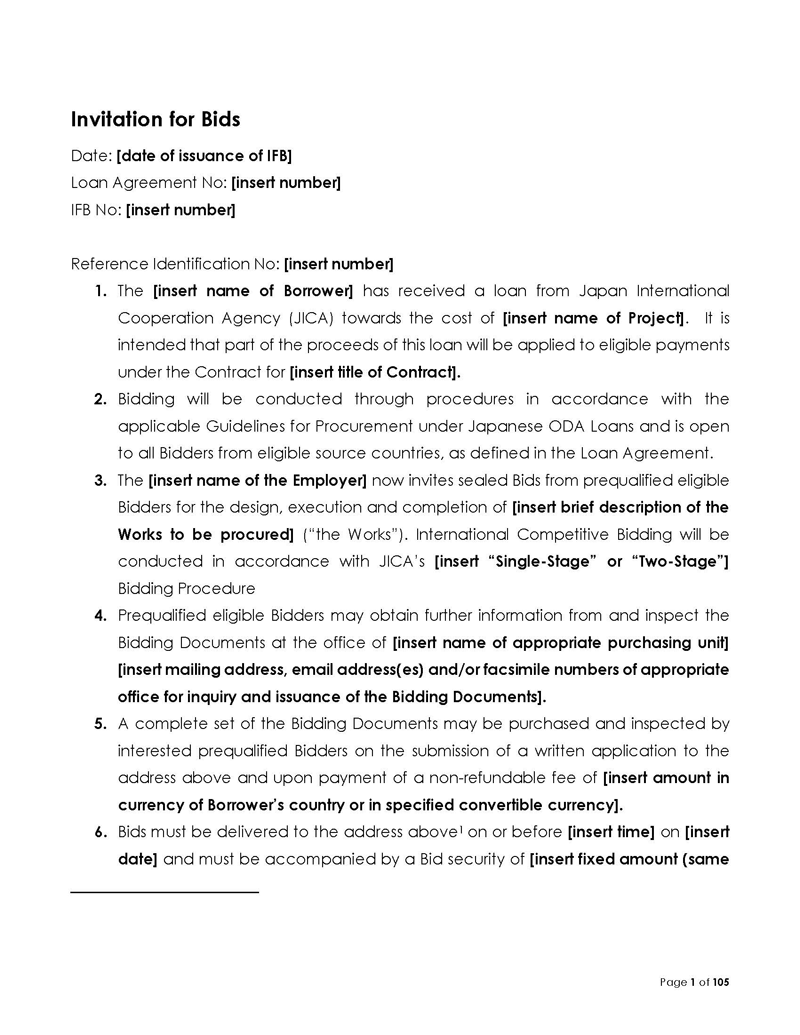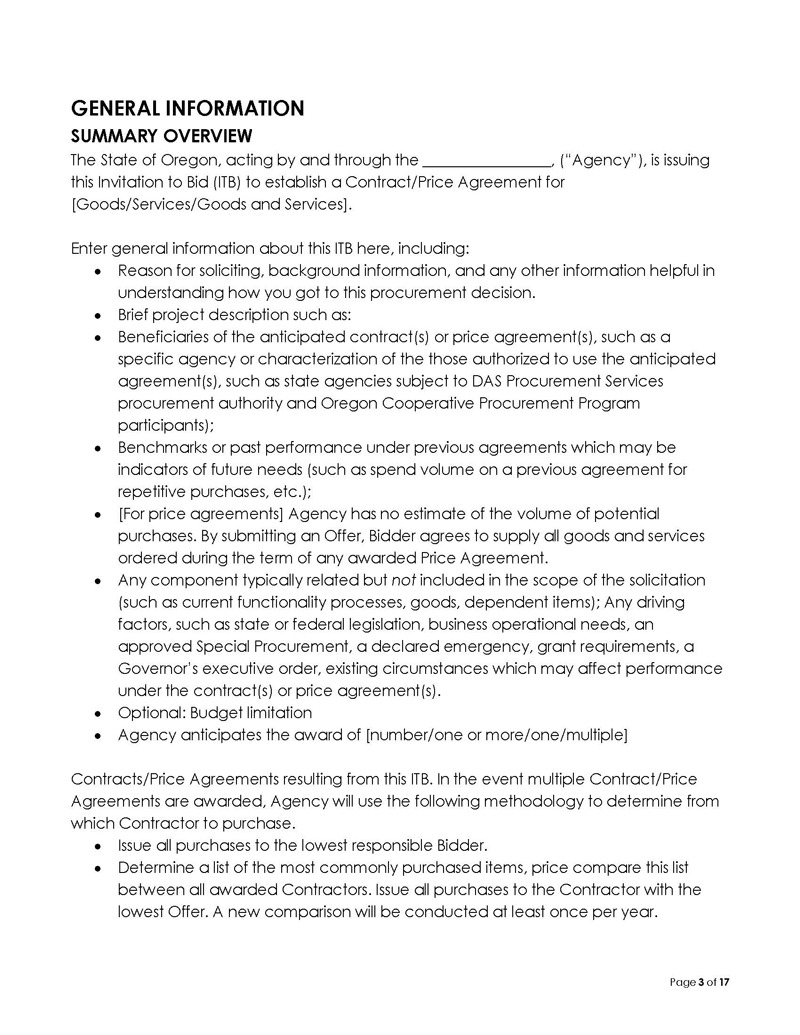An invitation for bid is a formal invitation for suppliers to offer specific goods or services to the invitee.
An IFB is typically used when the requirements are clear, and the evaluation decision will be based primarily on price. It can be used to contract goods and services like construction works, equipment supply, and trade contractors. It specifies the timelines for submitting applications and the selection process allowing all bidders to know when to expect the response. It also states the good or service to be supplied, the contract’s duration, and the completion deadlines.
To protect their interests, the client states the minimum acceptable quality and standard of the good or service to be supplied. Further, the requirements help to streamline the selection process to make it fair to the bidder and the company inviting the bids.
It aims to lock out unqualified bidders and balance the selection process by making it competitive among the qualified bidders; it is merit-based. The invitation may be sent outright once a company requires particular goods or services. Still, at times, the bids may be sent out to bidders who have filled out a pre-qualification questionnaire or had a pre-qualification interview. In response, the bidders are expected to respond with sealed bids, which shall be opened once the deadline for submission of the aforementioned bids passes.
Most companies pick the lowest bid because it is assumed all bidders provide the same good or service. Companies often focus on cost rather than quality, but they must balance both aspects of the project when selecting the vendor. The issue of quality is usually sorted by setting minimum standards expected, but some companies prefer to take a slightly pricier bid with better quality. Eventually, it depends on the preferences of the company.
Alternate names
It sometimes has alternate names depending on the expected response or state law. Some alternative names include:
- Invitation to bid
- Call for bids
- Call for tenders
- Invitation to tender
- Invitation to bid letter
- Bid invitation
When to Use It?
It is preferred where the contracting party has precise project details. Since the project details are available to the contracting party, the bid is easy to create and send out, and it saves on the costs of negotiations as the terms are set in the bid. The invitation is also preferred where there is a fixed budget for the project. It allows the contracting company to set the minimum acceptable standards and the price for the contract, leaving no room for negotiation.
The bidding process aims to be fair to the bidders by transparently conducting the selection process. Government agencies also issue IFBs as required by federal and state laws. Invitations to bid often result in a transparent tendering and selection process, which helps reduce corruption.
Characteristics of an Invitation for Bid
These bids are crucial to the success of a contracting party; as such, specific elements characterize this invitation.
They include:
Project-centered and specific
It focuses on the project. The contracting party must have a detailed and clear understanding of the project to be completed and the requirements for its completion. A clear understanding of the project affects the minimum acceptable standards set out in the bid; it will also affect the required warranties and other terms of service in the bid.
Based on the above factors, the bid must be specific and provide enough details to bidders. The bidders should understand the scope of duties, the quality of services expected of them, and how to tailor their responses to the bid.
Price-focused and competitive
Since the contracting party has a good understanding of the project and expected quality, the only difference between bidders is the price they will propose. Typically, the contracting party selects the lowest bid that meets their minimum standard. The bidding process then results in a fixed-price contract.
The bidder must calculate the project’s cost according to the bid’s details and determine whether they are tenable. Bidders should avoid responding with low and unsustainable bids to avoid incurring losses since they will have to complete the project within a fixed budget.
Used regularly in specific industries
Invitations to bids are usually used in specific industries because they promote transparency. Government and academic institutions prefer to issue invitations for bids as a way of enhancing transparency and fairness. They are preferred by institutions that face much public scrutiny, like universities and government agencies, because they provide standardized requirements. These requirements promote transparency and give every bidder a fair chance at winning the bid.
A valuable way to grow business
Mostly they result in good connections with satisfied clients. Bidders that successfully compete for and win these tenders build good business portfolios that improve their reputation.
Types of Invitations for Bid
They often vary regarding requirements and bidders that can submit bids. Since the projects have specific requirements, different bids accommodate different needs.
Some types of bids are:
Open tenders
Open tenders are the most preferred types used by public and private institutions. It is advertised in open tenders, and any qualified bidder submits their application for selection. Therefore, it is considered the most competitive tender because it gives everyone a fair chance. However, it can be tedious for the contracting company because they may receive a lot of bids, which still have to be analyzed carefully.
Restricted tenders
Based on their qualifications, restricted tenders are limited to a list of selected bidders. They are often used in fields with limited suppliers or bids for complex contracts. In restricted tenders, the contracting company researches and prepares a list of contractors that will fit the needs of the projects and then sends invitations to these pre-selected contractors. Restricted tenders are often advantageous for the contracting party but may exclude potential qualified suppliers with smaller businesses.
Double envelope system
The double envelope system requires bidders to submit a technical and price proposal. The contracting party assesses the technical proposal first and selects a list of qualified bidders from which they can choose one with an equally reasonable price proposal. The double envelope system is often used by contracting parties focusing more on the quality of work and less on the price.
Tender box
The tender box system allows bidders to submit their bids in the contracting party’s mailbox within the stipulated deadline. Once the deadline reaches, the appropriate procurement officer opens the mailbox in the presence of two witnesses. This system is considered fair because it is impartial and transparent.
Free Templates: Invitation for Bid



Invitation for Bid (IFB) Vs. Request for Proposal (RFP)
An IFB is a formal call for suppliers to submit bids for a specific project. In contrast, a request for proposal calls for contractors to provide proposals regarding a project.
Some of the differences between an IFB and a request for the proposal include the following:
- An IFB is used for simple projects like equipment supply, while RFPs are used for more complex and technical projects.
- IFBs specify the project, terms, and minimum standards, while RFPs give a general description of the project and focus more on the expected product.
- Since IFBs are for predictable projects, there is usually no room for negotiation, and the selection committee’s decision is considered final. RFPs, on the other hand, allow bidders to submit their proposals in different ways the projects can be done and negotiated.
- IFBs focus more on the project’s price because all the suppliers are assumed to be qualified. On the other hand, RFPs concentrate more on the technical aspect and qualifications of the bidders because the projects considered are more complex.
Essential Components of an Invitation to Bid
It must cover the technical aspects of the project. In addition, the invitation must contain instructions to guide the bidders on how to respond and to give them an understanding of the project.
They include:
- An introduction as to the general purpose of the invitation
- The background of the project
- The legal considerations
- Maintenance obligations
- The required response
- Deadlines for selection
- The qualifications and minimum standards
Legal considerations
Government institutions often use these invitations to enhance fairness in the process. It needs to be advertised as widely as possible to give everyone a chance to submit their proposal. It may be posted on the institutions’ websites or in newspapers of wide circulation. Some of the tendering processes may be conducted electronically through e-procurement.
How to Write an Invitation for Bid?
While there is no standard way of writing it, the general bid has to follow a particular format and have specific sections. These invitations are precise, and the requirements for the product or project must be reflected in how the bid is written.
You can follow the steps below when writing your bid:
- Create the company’s letterhead and include all the official details and contact information.
- Indicate the intended recipient. For open tenders, the IFBs should be published on the institution’s websites if required by law to do so. If the IFB is for restricted tendering, the recipients should receive separate invitations.
- Indicate the project name and pertinent details about the project.
- Indicate the scope of work to be covered by the project and any additional services.
- State minimum qualifications expected of bidders.
- Indicate the requirements for submitting the bid.
- Leave a blank space for the bidder’s response.
- Indicate the timelines for the selection process.
Negotiating Tips
After receiving bids, contracting parties may find it hard to select the bids because of a few missing requirements. To cure such issues, they may need to negotiate with a bidder before establishing a fixed contract.
Here are a few valuable tips you should use when negotiating with a bidder:
- Set the objective of the negotiation before meeting the vendor. Use it as your guide through the negotiation.
- Analyze the bid and response by the vendor and make a list of the issues to be negotiated.
- When making the list of issues, list them on a priority basis, beginning with the most important.
- Keep an open mind and allow the vendor to offer their opinion; they might provide valuable solutions.
- Avoid arguing with the bidders; this is considered unprofessional.
Additional note
IFBs are easy to select contractors since they mainly focus on the price. However, it is good to consider other technical considerations, especially regarding the standard of work and reputation of the bidders. Unfortunately, the issue with assessing only the cost of the project is that companies may fail to consider the expertise and reputation of the vendor. As a result, the company may select a vendor that underbid the contract rather than a more experienced vendor.
Wrapping Up
IFBs are an excellent way for contracting organizations to select good contractors within the budget. The process allows for the submission of different bids giving the contracting party a good selection. However, since they focus more on price, they may not be suitable for complex and technical projects which require more scrutiny of the bidders’ experience and qualifications. Before issuing an IFB, a company should consider whether the project is for a simple supply of a good or a quick project. It is recommended to research more on the vendors that respond before selecting the most suitable one. This research can be done by looking through company profiles and assessing their reviews on marketing platforms.




